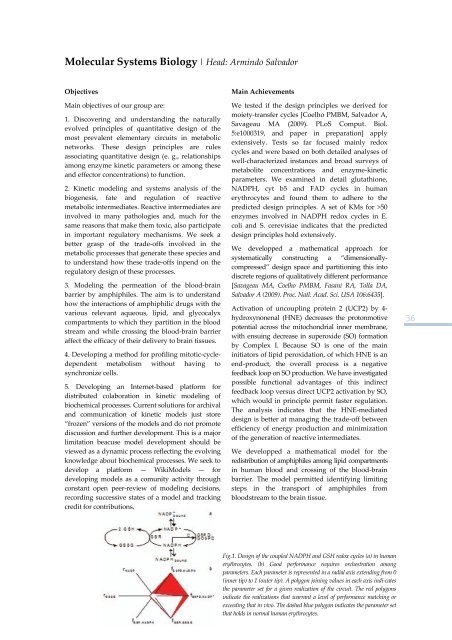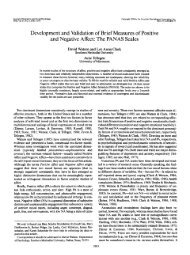Annual Report of Activities CNC 2008 - Center for Neuroscience and ...
Annual Report of Activities CNC 2008 - Center for Neuroscience and ...
Annual Report of Activities CNC 2008 - Center for Neuroscience and ...
Create successful ePaper yourself
Turn your PDF publications into a flip-book with our unique Google optimized e-Paper software.
Molecular Systems Biology | Head: Armindo SalvadorObjectivesMain objectives <strong>of</strong> our group are:1. Discovering <strong>and</strong> underst<strong>and</strong>ing the naturallyevolved principles <strong>of</strong> quantitative design <strong>of</strong> themost prevalent elementary circuits in metabolicnetworks. These design principles are rulesassociating quantitative design (e. g., relationshipsamong enzyme kinetic parameters or among these<strong>and</strong> effector concentrations) to function.2. Kinetic modeling <strong>and</strong> systems analysis <strong>of</strong> thebiogenesis, fate <strong>and</strong> regulation <strong>of</strong> reactivemetabolic intermediates. Reactive intermediates areinvolved in many pathologies <strong>and</strong>, much <strong>for</strong> thesame reasons that make them toxic, also participatein important regulatory mechanisms. We seek abetter grasp <strong>of</strong> the trade‐<strong>of</strong>fs involved in themetabolic processes that generate these species <strong>and</strong>to underst<strong>and</strong> how these trade‐<strong>of</strong>fs inpend on theregulatory design <strong>of</strong> these processes.3. Modeling the permeation <strong>of</strong> the blood‐brainbarrier by amphiphiles. The aim is to underst<strong>and</strong>how the interactions <strong>of</strong> amphiphilic drugs with thevarious relevant aqueous, lipid, <strong>and</strong> glycocalyxcompartments to which they partition in the bloodstream <strong>and</strong> while crossing the blood‐brain barrieraffect the efficacy <strong>of</strong> their delivery to brain tissues.4. Developing a method <strong>for</strong> pr<strong>of</strong>iling mitotic‐cycledependentmetabolism without having tosynchronize cells.5. Developing an Internet‐based plat<strong>for</strong>m <strong>for</strong>distributed colaboration in kinetic modeling <strong>of</strong>biochemical processes. Current solutions <strong>for</strong> archival<strong>and</strong> communication <strong>of</strong> kinetic models just store“frozen” versions <strong>of</strong> the models <strong>and</strong> do not promotediscussion <strong>and</strong> further development. This is a majorlimitation beacuse model development should beviewed as a dynamic process reflecting the evolvingknowledge about biochemical processes. We seek todevelop a plat<strong>for</strong>m — WikiModels — <strong>for</strong>developing models as a comunity activity throughconstant open peer‐review <strong>of</strong> modeling decisions,recording successive states <strong>of</strong> a model <strong>and</strong> trackingcredit <strong>for</strong> contributions.Main AchievementsWe tested if the design principles we derived <strong>for</strong>moiety‐transfer cycles [Coelho PMBM, Salvador A,Savageau MA (2009). PLoS Comput. Biol.5:e1000319, <strong>and</strong> paper in preparation] applyextensively. Tests so far focused mainly redoxcycles <strong>and</strong> were based on both detailed analyses <strong>of</strong>well‐characterized instances <strong>and</strong> broad surveys <strong>of</strong>metabolite concentrations <strong>and</strong> enzyme‐kineticparameters. We examined in detail glutathione,NADPH, cyt b5 <strong>and</strong> FAD cycles in humanerythrocytes <strong>and</strong> found them to adhere to thepredicted design principles. A set <strong>of</strong> KMs <strong>for</strong> >50enzymes involved in NADPH redox cycles in E.coli <strong>and</strong> S. cerevisiae indicates that the predicteddesign principles hold extensively.We developped a mathematical approach <strong>for</strong>systematically constructing a “dimensionallycompressed”design space <strong>and</strong> partitioning this intodiscrete regions <strong>of</strong> qualitatively different per<strong>for</strong>mance[Savageau MA, Coelho PMBM, Fasani RA, Tolla DA,Salvador A (2009). Proc. Natl. Acad. Sci. USA 106:6435].Activation <strong>of</strong> uncoupling protein 2 (UCP2) by 4‐hydroxynonenal (HNE) decreases the protonmotivepotential across the mitochondrial inner membrane,with ensuing decrease in superoxide (SO) <strong>for</strong>mationby Complex I. Because SO is one <strong>of</strong> the maininitiators <strong>of</strong> lipid peroxidation, <strong>of</strong> which HNE is anend‐product, the overall process is a negativefeedback loop on SO production. We have investigatedpossible functional advantages <strong>of</strong> this indirectfeedback loop versus direct UCP2 activation by SO,which would in principle permit faster regulation.The analysis indicates that the HNE‐mediateddesign is better at managing the trade‐<strong>of</strong>f betweenefficiency <strong>of</strong> energy production <strong>and</strong> minimization<strong>of</strong> the generation <strong>of</strong> reactive intermediates.We developped a mathematical model <strong>for</strong> theredistribution <strong>of</strong> amphiphiles among lipid compartmentsin human blood <strong>and</strong> crossing <strong>of</strong> the blood‐brainbarrier. The model permitted identifying limitingsteps in the transport <strong>of</strong> amphiphiles frombloodstream to the brain tissue.36Fig.1. Design <strong>of</strong> the coupled NADPH <strong>and</strong> GSH redox cycles (a) in humanerythrocytes. (b) Good per<strong>for</strong>mance requires orchestration amongparameters. Each parameter is represented in a radial axis extending from 0(inner tip) to 1 (outer tip). A polygon joining values in each axis indi‐catesthe parameter set <strong>for</strong> a given realization <strong>of</strong> the circuit. The red polygonsindicate the realizations that warrant a level <strong>of</strong> per<strong>for</strong>mance matching orexceeding that in vivo. The dashed blue polygon indicates the parameter setthat holds in normal human erythrocytes.






